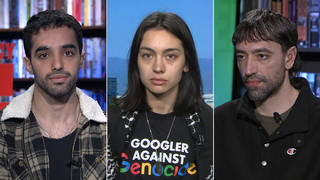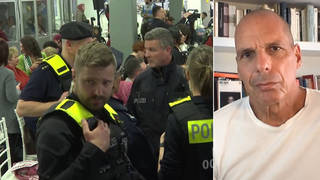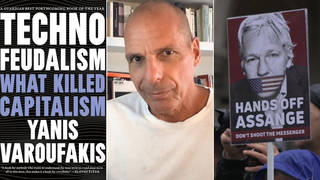
Related
Attorney General William Barr announced Thursday that the federal government is resuming the death penalty after nearly two decades. The execution of five death row prisoners were immediately ordered beginning in December. There are currently 62 prisoners on federal death row, including white supremacist Dylann Roof, who murdered nine black worshipers at the historic Emanuel AME Church in June 2015, and Boston Marathon bomber Dzhokhar Tsarnaev. Federal prosecutors are expected to push for the death penalty in both cases. This news comes despite a growing movement opposing the death penalty in the United States. The United Nations has called for a global ban on the practice, and Amnesty International calls it “the ultimate cruel, inhuman and degrading punishment.” We speak with Ruth Friedman, director of the Federal Capital Habeas Project, which coordinates representation, represents defendants and monitors federal death row.
Transcript
AMY GOODMAN: The federal government is resuming the death penalty after a more than 15-year moratorium. Attorney General William Barr announced the news Thursday, immediately ordering the execution of five death row prisoners beginning in December. More are expected to be scheduled. In a statement, Attorney General Barr said, quote, “The Justice Department upholds the rule of law—and we owe it to the victims and their families to carry forward the sentence imposed by our justice system,” he said.
There are currently 62 prisoners on federal death row, including white supremacist Dylann Roof, who murdered nine black worshipers at the historic Emanuel AME Church in June 2015, and Boston Marathon bomber Dzhokhar Tsarnaev. Federal prosecutors are expected to push for the death penalty in both cases. The federal government hasn’t put a prisoner to death since 2003.
This news comes despite a growing movement opposing the death penalty in the United States. Advocates say they’ll fight the decision in courts, calling the death penalty racist and immoral. 2020 candidates, including Senator Kamala Harris, Bernie Sanders, Elizabeth Warren, all have condemned the announcement. Joe Biden announced his opposition to the death penalty earlier this week.
Executions will be done via lethal injection, no longer a three-drug cocktail, but one drug, pentobarbital. A number of states, including Texas and Ohio, have used the drug to kill prisoners, but pharmaceutical companies have in recent years objected to their products being used for capital punishment. It’s not known where the drug would be obtained for these federal executions.
Experts say capital punishment does not help deter homicides and that errors and racism in the criminal justice system extends to those sentenced to death. According to the Death Penalty Information Center, more than 160 people who had been wrongly convicted and sentenced to death have been exonerated since 1973.
The death penalty has been abolished in 106 countries, with another 28 having moratoriums or effectively not using the practice. The United Nations has called for a global ban on the practice, and Amnesty International calls it “the ultimate cruel, inhuman and degrading punishment.”
Well, for more, we go to Ruth Friedman, director of the Federal Capital Habeas Project, which coordinates representation, represents defendants and monitors federal death row.
Welcome to Democracy Now!, Ruth Friedman. Can you respond to this announcement? Were you surprised by this announcement by the attorney general, Barr, yesterday?
RUTH FRIEDMAN: We were absolutely surprised. We learned about it at the same time the rest of the public did.
It’s important to know the government has had eight years to come up with an execution protocol. There’s been ongoing litigation over lethal injection, which is true around the country, we’ve seen in all the states. And it’s been true in the federal government. And the government announced eight years ago it did not have the drugs necessary to carry out an execution. And as part of litigation, it said, “We will let the court know we are working on it.” And every few months they gave an update to the court, saying, “We’re not ready. We don’t have a protocol. We don’t have a protocol.”
Yesterday they announced a protocol. And at the same time, instead of going through the judicial process, they set execution dates on five individuals who were not part of that litigation. And therefore, they were able to avoid judicial scrutiny of what they were doing. They dropped it suddenly yesterday, and we were very surprised to see it.
AMY GOODMAN: So, talk about the people immediately not only saying they’re reinstating the federal death penalty, but that five people would be scheduled for execution immediately, starting, I think, in December. And then this issue of there’s been a three-drug cocktail used, which has often stopped states from executing prisoners, because they can’t get the drugs, and now just saying they will use one drug, pentobarbital.
RUTH FRIEDMAN: And the real problem there is the same. If you avoid any judicial scrutiny or any public awareness of where that drug came from, we have no idea. We don’t know if it was imported. We don’t know if it was manufactured. There’s no sunlight in the process. There’s no transparency. They did not go through the Administrative Procedures Act, which is just what this kind of regulation was designed for, so that the public would have some idea of what kind of drug they were using, particularly after such a hiatus.
And again, they went after five people for whom they did not have stays of execution. As part of this ongoing, orderly litigation in the district court in the District of Columbia, they were litigating this issue, and they were saying, “We’re not ready. We’re not ready.” Instead of sticking with that litigation, they went around it. And it’s an end run around the court. We don’t know where this drug came from.
AMY GOODMAN: And—
RUTH FRIEDMAN: Several months ago, the—
AMY GOODMAN: Go ahead.
RUTH FRIEDMAN: Go ahead. Several months ago, the federal government released, the Department of Justice released, an opinion from the Office of Legal Counsel saying that drugs used in executions are not drugs, and therefore they’re not subject to FDA rules and scrutiny. And so, therefore, we don’t know anything about the drugs that they’re planning to use.
AMY GOODMAN: So, talk about racial bias and the death penalty. According to the Death Penalty Information Center, almost 42% of death row—federal death row prisoners are black, when the overall population is 14%. And we know, of course, that if a white person is killed, the perpetrator is far more likely to get the death penalty.
RUTH FRIEDMAN: That’s exactly right. And it shows one of the ways in which the federal death penalty—the problems with the federal death penalty are the same as those that we’ve seen in the states for years now, and what is leading many people in this country, including conservatives, to turn away from the use of the death penalty. The federal death penalty is no different. It suffers from the exact same flaws, including racial discrimination. In some ways, the federal government is worse than that’s true of many of the states. What you see is an absolute overabundance, that you were pointing to, of people of color, particularly black men. The same kind of issues that plagued or that led this country to come up in the ’90s with policies that people are now turning away from, that led to mass incarceration, and particularly mass incarceration of African-American men, are seen just as well in the death penalty and in the federal death penalty.
And I think people are starting to say, “Wait a second. How does this happen?” And I think many people have thought that the federal death penalty somehow is the gold standard of capital punishment systems. And that’s simply not true. When you start to look at it, it suffers from the same flaws. One of those is racial bias. Another of those is having lawyers who are not qualified, are not able to have the time or the resources or the knowledge that these kind of cases require. And so you see problems in these cases that you see all over the country. You see the use of junk science. You see the use of false representations by the government, government misconduct. And I think you’re going to see more and more of that coming to light now that the public is getting a spotlight on the federal death penalty.
AMY GOODMAN: President Trump has repeatedly pushed for increasing the use of capital punishment, including as a penalty for drug offenses. This is Trump speaking last year in New Hampshire.
*PRESIDENT DONALD TRUMP: But the ultimate penalty has to be the death penalty. … Unless you have really, really powerful penalties, led by the death penalty, for the really bad pushers and abusers, we are going to get nowhere. And I’m telling you, we are going to get somewhere.
AMY GOODMAN: And last December, Trump said he hoped China would employ the death penalty against traffickers of the synthetic opioid fentanyl. Ruth Friedman, your response?
RUTH FRIEDMAN: I think this is an example of just how inherently political a tool the death penalty is. If you’re going to have the awesome power to make these decisions and to say you’re going for the worst of the worst, then you have to have a fair process, with fair lawyers, with lawyers who are able to litigate these cases, and you can’t lie, and you can’t use junk science to put people on the death row. In our death row, we have three states that contribute almost half of all death sentences. If this weren’t a political system at all, why would that be true? Do Virginia, Texas and Missouri really have the worst crimes in the entire country, such that there are 50 states, but the three of them contribute almost half of the death sentences? These decisions are made on the basis of politics. And I think that kind of grandstanding is an example of it.
AMY GOODMAN: Speak–
RUTH FRIEDMAN: We can see that—please, go ahead.
AMY GOODMAN: Go ahead.
RUTH FRIEDMAN: I was going to say, I think what’s used to justify these kind of statements is that it’s a deterrent; we are going along with the wishes of the victim’s family. And I think every single study that has looked into this says it is not a deterrent. You are not making people safer. It’s the use of money, in fact, toward putting people on death row and keeping people on death row, which we know is much more expensive, that could be used to solving unsolved crimes, looking at untested rape kits and the like, which is, again, why many people are turning away from this. And as to victims’ families, you will find there’s a big, big difference among families about what they want. And the federal government does not always follow those wishes.
AMY GOODMAN: Since 1963, the federal government has executed three people, including Timothy McVeigh, who was put to death in June 2001 for the Oklahoma City Federal Building bombing that killed 168 people. I want to turn to Bud Welch, who became a leading anti-death penalty advocate after losing his daughter Julie in the 1995 Oklahoma City bombing. I interviewed Bud Welch on Democracy Now! in 2015.
BUD WELCH: The punishment of the death penalty is nothing more than revenge. And I went through almost a year of revenge after Julie’s death, and—revenge and hate. And one cannot go through the healing process at all when you’re living with revenge. And that’s all the death penalty is, is revenge. It is not a deterrent. It doesn’t, as the media says, bring closure to family members.
There are a lot of victims’ family members here in Oklahoma City that I know, because I spent 13 years on the board of directors of the Oklahoma City National Memorial, and they were looking for the word “closure” at the time McVeigh was executed, on June the 11th of 2001. And I had been telling many of those people that the day that we would take Tim McVeigh from his cage and we would kill him would not be part of their healing process. And they learned that after his death. And many of those people have come forward now and said, “It was a mistake for us to kill Tim McVeigh,” because what it did was revictimize them all over again.
AMY GOODMAN: Again, that was Bud Welch, who lost his daughter Julie in the Oklahoma City bombing, speaking out against the death penalty. Ruth Friedman, can we end by you talking about exonerations, people who have been exonerated from death row, over 160 people?
RUTH FRIEDMAN: Absolutely. If you look at this as a government program, would we ever be as comfortable saying we can make this many mistakes and yet continue on in the same vein? And you’re going to see more and more of that. And that, again, is why people are turning away from it. They are recognizing that we make too many mistakes. We can’t trust our governments with these kind of decisions. It’s also why we’re an outlier in the world.
And the federal government, unfortunately, is also going to become an outlier in the country. You see death sentences going way down, because—in large part, I think, because of the exonerations and people understanding that, “Wait a second. That person had a trial, that person had an appeal, and yet we still got it wrong.” And the same can be true about sentences. We can make mistakes. And I think people are coming to see that more and more. Unfortunately, while the rest of the world and the rest of the country is moving in one direction, the federal government is moving in another. And that is extremely unfortunate.
AMY GOODMAN: I mean, this country was going in the direction of overturning the death penalty overall, state after state. Can you give us the figures on this and what this means, reinstating the federal death penalty but perhaps states say no?
RUTH FRIEDMAN: I think it shows, again, why this has become a political process, or always has been a political process. When you look at the federal death penalty, as you said, the states are moving away. And we’ve had state legislatures that are dominated by Republican or conservative legislators, that are also saying, “We don’t want this. It’s not good for our community. It’s not the way we want to be spending our resources. Or it’s not how we think we make our citizens safer.”
So, instead, you have the federal government moving into some of these areas and saying, “Well, we’re going to take a case.” So you have people on federal death row, for example, who were already tried in the state courts, were already serving very long sentences, but the federal government wanted to step in. It’s another misconception and myth about the federal death penalty that it is somehow these unique federal interests, where people are there for treason and spying and the like, when it’s not true. Everybody could have been prosecuted in state court who’s on federal death penalty and—is on the federal death row. And very often the connection between a federal interest is extremely attenuated. And I think people would very be surprised to learn about that.
AMY GOODMAN: Just 30 seconds. The people that Barr has said they will execute, they will execute more people—they will try to—five prisoners, than have been executed on federal death row in over 50 years.
RUTH FRIEDMAN: Well, you have to wonder, as I said: Why did they choose five people who were not—who did not have stays of execution, who were not in a position to be part of a challenge to the method of execution, to how the federal government was planning to use its awesome power? I think that was a cynical, end-run decision, keeping it out of the Administrative Procedures Act’s review process, keeping it out of the court’s scrutiny. I think that’s how those people were chosen, which, again, is—that’s not good government. That’s not transparency. That’s not a willingness to say this is how we do things, this is how we make decisions. It’s a political response, and that is extremely unfortunate for all of us.
AMY GOODMAN: Ruth Friedman, we want to thank you for being with us, director of the Federal Capital Habeas Project, which coordinates representation, represents defendants, monitors federal death row.
When we come back, a federal judge temporarily blocks President Trump’s plan to bar nearly all migrants from seeking asylum in the United States. Stay with us.












Media Options